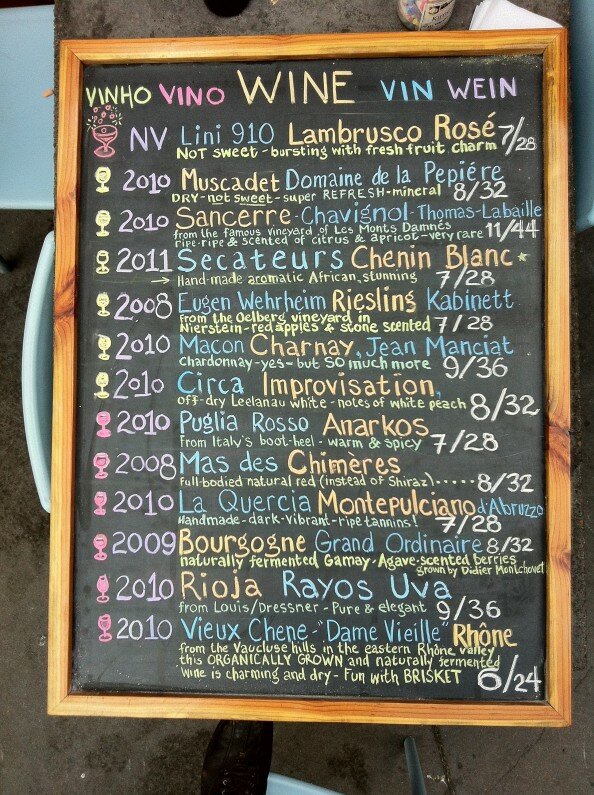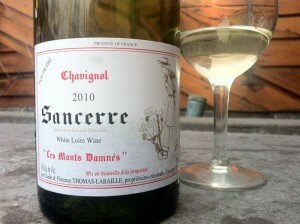Editor’s note: Another appropriated communication on the subject of new wine at Slows from local wine authority, Putnam Weekley. Though intended solely to educate the staff, again, there is so much excellent general information on wine that it must be shared.
This week there are an unusually large number of new wines at Slows.
Ulacia Txakolina,
Verasol MCS,
Montsarra Cava,
Domaine Sonoma Cabernet Sauvignon
Dr. Thanisch Riesling (“Sofia’s”)
New Items:
NV Lini 910 Lambrusco Rosé
2010 Thomas-Labaille Sancerre, Chavignol, Les Monts Damnés
2009 Didier Montchovet Bourgogne Grand Ordinaire
2008 Eugen Wehrheim Riesling Kabinett, Niersteiner Oelberg
2009 Vieux Chene, VdP Vaucluse, Cuvee de la Dame Vieille
LAMBRUSCO
The Lambrusco label will look familiar to most of you. Last year we carried a similar wine from the same producer, their “Rosso.”
This so-called Rosé is fairly dark in color. Think of it as a very light colored red. And while grouping wines into broad, visibly evident categories – Like “Rosé Wines” – is easy and quick, that approach will help explain conformist wines better than distinctive ones. In other words, we are right to prefer the renegade over the predictable. So before considering Lini’s Rosé you might want to forget what you know about pink wine.
Lambrusco is a grape variety associated with the Italian province of Emilia and the culturally rich city of Bologna. It is commonly equated with a sweet factory made drink sold under the Riunite brand. (“Riunite on Ice, So Nice.”) This, however, is quite a bit different. It’s dry, for one thing, and the wine-growing is on a smaller and slower scale. It is less processed.
Is it sparkling? Yes. To be more specific, it is frizzante, which means it has about half the gas of a Champagne-method wine.
The Lini family established their winery in 1910, hence the name.
A 5 oz. coupe holds about 4 oz. and it costs $7. A bottle is a sensational value at $28 and it is the easiest thing in the world to drink – not boozy, tannic or heavy – in fact the opposite.
It tastes delicious. It will not clash with any of our foods, so in one sense it will pair well with any of them. However, I think this is less of a food companion than it is a pure drinker, before a meal, after a shift, whenever drinking will be done.
Sancerre is a French region in the upper Loire valley. White Sancerre is always 100% Sauvignon Blanc. Within Sancerre, the town of Chavignol is known to produce particularly ripe and sturdy wines. And there is one more distinction to mention, the vineyard: Les Monts Damnés. (Damnation Mountain)
Les Monts Damnés is a unique slope in Chavignol. It is aimed and curved toward the south in a way that amplifies the sun’s rays making for a unique ripening of the grapes. Here are photos of it: http://jimsloire.blogspot.com/2012/04/sancerre-monts-damnes-views.html
Kimmeridgian Marl makes up the soils in Burgundy, Champagne and Chavignol and it is the greatest dirt in the world!: http://www.winegeeks.com/articles/139
This is truly a rare find. I would be shocked if this were offered by the glass anywhere else in Michigan, or even in the Midwest. Slows sells a 5 oz. pour for $11, a bottle for $44. The only other restaurant I could find selling it in the country is in North Carolina where it is sold by the bottle for $52.
How does it taste? Rather like a Chablis-Sancerre hybrid of sorts. It is racy and scented of diverse fruits and plants: apples, citrus, apricot, dandelion stems, stone, and clover. It combines richness, persistence and precise detail in a unique way. By contrast, brand name Sauvignon Blanc wines from New Zealand will taste noticeably more herbaceous and of grapefruit, and cloying, with alcohols out of whack. Other wines from Sancerre are leaner and more ephemeral than this. This bottle can develop and reward patience as it ages.
Your takeaway: While this is indeed “a Sauvignon Blanc,” selling it as such would be wildly short of the mark. This is a classic Les Monts Damnés, a great Sancerre, and if it can even be considered representative of Sauvignon Blanc, this is one of its greatest expressions found on earth.
This will pair well with the Slows cheese trio – mac, hoffmans, and enchiladas. Also it will complement blackened catfish, rare salmon, and the various chicken based items – wings, yardbird, strut, breast.
BGO – BOURGOGNE GRAND ORDINAIRE
Everyone knows Red Burgundy – or Bourgogne Rouge – is made from Pinot Noir. But there are two exceptions: Passetoutgrains, which is typically a blend of Gamay and Pinot Noir, and Bourgogne Grand Ordinaire. In this case we are drinking a wine made from Gamay. Gamay, incidentally, is the grape that makes Beaujolais in its region just to the south.
This is a good example of strictly “Natural Wine.” The grapes are certified biodynamic and almost nothing was added to the wine during fermentation and aging. The idea is to capture the whole taste of the fruit and the vineyard. And indeed, this is a charming bundle of Gamay goodness, tempered with a bit of bottle age. It is light bodied, dry and berryish on the palate. And as its fruit-flavored baby fat has worn away over time, there is emerging a distinctive earthy flavor that might remind you of Agave (see Mescal and Tequila.) This comes from the whole pulpy mess of fruit and the diverse microbes that get the fermentation going after the grapes are picked. In a perfect world I’d like to see this served a bit cooler than room temperature. Ice-bathe the bottle for 3-5 minutes if you want to see what I mean.
Consider allowing someone asking for “Pinot Noir” to taste this (and with an additional sample of the Rayos Uva Rioja they will know the two best and very different alternatives.)
Pair this with pork in all its forms, but especially in the form of a Reason sandwich.
$8 / $32
OIL MOUNTAIN RIESLING
This Riesling has been seen on our list twice before. It is from a single vineyard in the German region of Rheinhessen and it is off-dry, semi-sweet, fruity – whatever you want to call it. The reason it’s sweet is that Riesling, and wines from this far north in general, tend to have so much natural acidity that residual fruit sugar is an important balancing element to the flavors. The Oelberg (Oil Mountain) vineyard is in the township of Nierstein, and it is one of the few esteemed vineyard sites in the Rheinhessen.
The best way to experience Riesling is to concentrate on the aromas. There is really a lot going on in there. Smell it for at least a minute before you even take a taste. Red apples, preserved lemons, flinty mineral and stone sensations, and all of it is fairly intense and organized.
This wine certainly can pair with fish and chicken, but there is one unorthodox pairing that I like even better: brisket. There is a groomed classic personality to both the wine and the meat that speak to each other. The meat does not “overwhelm” the wine, or at least not completely. Consider having that with a side of green beans and potato salad or sweet mash.
Still $7 / $28
RHONE
Vieux Chene (Old Oak) is an estate in the hills that join the Rhone Valley to Provence in southern France. This is from a certified organic farm.
It is made with Grenache from very old vines (old vines produce more concentrated and complex wine) and younger plantings of Syrah, Mourvedre, Cinsault and Merlot. This is a perfectly ripe, dry and drinkable every day red wine. It’s lack of pretense and complication is in direct proportion to its charm, good flavor and utility.
This will pair well and complement virtually everything on the menu. Vieux Chene rocks.
Medium-bodied. $6 / $24 … another astonishing bargain
http://www.bouche-duvieuxchene.com/wines/fiande2.htm
I’ve become a little obsessed with our Ferreira White Port. As a concept, White Port has a few knocks against it. 1) It is not an antique tradition – the first white port was bottled sometime in the past 100 years, and there is little coherence to the various styles that would exemplify it. 2) It is an obscure subset of an already niche wine, that being the standard ports, ruby and tawny, made with red grapes. And 3) There are some expectedly shoddy “white port” knockoffs made in the central valley of California which tend to appear in liquor stores in poor neighborhoods – a perfectly legitimate if quick and cheap alcohol high.
This wine however is worth some serious consideration and reflection. Comparisons to good Sherry and Madeira are warranted. All have a certain nutty aroma that does indeed invite pairing them with roasted almonds. All are fortified – meaning the natural sugar in the grapes was preserved by halting fermentation by way of an added dose of neutral grape spirits. So it’s strong and a bit sweet. But so, …, balanced. This has aromas and scents of baked apples, peppered candied lemons, fresh figs, hazelnuts, apricots, and rainier cherries.
This is typically thought of as an aperitif (moreso in France) or digestif (moreso in England) but I had a hunch that this would actually pair well with a JP’s revenge. So on Friday I sat at table 209 and tested my theory. It was the wine and sandwich equivalent of bacon on a Chuck Norris, or to name a sanctioned classic, Sauternes and Fois Gras. Two incredibly rich and succulent flavors brought together to amplify and complement the other. And in spite of the decadent flavors, it actually made a rejuvenating meal.
That’s plenty to think about for now. Please call, write or see me to offer your insights or to pose questions.
Thanks for reading,
Putnam


